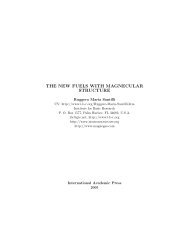brst symmetry in cohomological hamiltonian mechanics - Institute for ...
brst symmetry in cohomological hamiltonian mechanics - Institute for ...
brst symmetry in cohomological hamiltonian mechanics - Institute for ...
Create successful ePaper yourself
Turn your PDF publications into a flip-book with our unique Google optimized e-Paper software.
1 The BRST approach<br />
We consider one-dimensional field theory, <strong>in</strong> which the dynamical variable is<br />
the map, a i (t) : M 1 → M 2n , from one-dimensional space M 1 , t ∈ M 1 , to<br />
2n-dimensional symplectic manifold M 2n .<br />
The commut<strong>in</strong>g fields a i = (p 1 , . . . , p n , q 1 , . . . , q n ) are local coord<strong>in</strong>ates on<br />
the target space, phase space of Hamiltonian <strong>mechanics</strong> equipped with the<br />
closed non-degenerate symplectic two-<strong>for</strong>m, ω = 1 2 ω ijda i ∧ da j ; ω ij = −ω ji =<br />
const, ω ij ω jk = δ i k.<br />
We start with the partition function<br />
∫<br />
Z = Da exp(iI 0 ), (1)<br />
where I 0 = ∫ dtL 0 , and take the Lagrangian to be trivial, L 0 = 0. This<br />
Lagrangian has symmetries more than the usual diffeomorphism <strong>in</strong>variance.<br />
Trivial Lagrangians are known to be of much significance <strong>in</strong> the <strong>cohomological</strong><br />
quantum field theories[1]-[4], which can be derived by an appropriate<br />
BRST gauge fix<strong>in</strong>g of a theory <strong>in</strong> which the underly<strong>in</strong>g Lagrangian is zero.<br />
We use the BRST gauge fix<strong>in</strong>g scheme[5, 6] to fix the <strong>symmetry</strong> <strong>in</strong> (1)<br />
by <strong>in</strong>troduc<strong>in</strong>g appropriate ghost and anti-ghost fields. The diffeomorphisms<br />
of M 2n we are <strong>in</strong>terested <strong>in</strong> are the symplectic diffeomorphisms, which leave<br />
the symplectic tensor ω ij <strong>for</strong>m <strong>in</strong>variant[7],<br />
δa i = l h a i , (2)<br />
where l h = h i ∂ i is a Lie-derivative along the vector field h i . To garantee the<br />
<strong>in</strong>variance of ω ij , we take h i to be Hamiltonian vector field[8], h i = ω ij ∂ j H(a),<br />
where we assume H to be Hamiltonian of classical <strong>mechanics</strong>.<br />
By <strong>in</strong>troduc<strong>in</strong>g the ghost field c i (t) and the anti-ghost field ¯c i (t) , we write<br />
the BRST version of the diffeomorphism (2),<br />
sa i = ic i , sc i = 0, s¯c i = q i , sq i = 0, (3)<br />
where the BRST operator is nilpotent, s 2 = 0, and q i is a Lagrange multiplier.<br />
By an obvious mirror <strong>symmetry</strong> to the BRST trans<strong>for</strong>mations (3), we demand<br />
the follow<strong>in</strong>g anti-BRST trans<strong>for</strong>mations hold:<br />
¯sa i = i¯c i , ¯s¯c i = 0, ¯sc i = q i , ¯sq i = 0, (4)<br />
1














